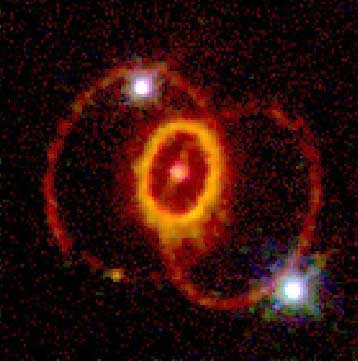
பிரபஞ்சத்தில் தினமும் நட்சத்திரங்கள் தோன்றுவதும் மறைவதும் மிக இயல்பான் செயல்.சில நட்சத்திரங்கள் அதன் முடிவாக் வெடித்து சிதறுவதை சூப்பர் நோவா(supernova) என்று அழைக்கிறோம்.இது 100 பில்லியன் சூரியன்களின் 10 பில்லியன் வருட வெப்ப பரவலுக்கு(radiation) சம்மானது.இந்த சூப்பர் நோவா உயிர்களின் உருவாதலுக்கு காரணமாக் இருந்திருக்கலாம் என்று கருதப் படுகிறது.
இக்காணொளி அது குறித்த பல அம்சங்களை அலசுகிறது.
How many stars are born and die each day?
ReplyDeleteWe usually talk of star formation in terms of the gas mass that is converted into stars each year. We call this the star formation rate. In the Milky Way right now, the star formation rate is about 3 solar masses per year (i.e. three times the mass of the Sun's worth of star is produced each year). The stars formed can either be more or less massive than the Sun, though less massive stars are more numerous. So roughly if we assume that on average the stars formed have the same mass as the Sun, then the Milky Way produces about 3 new stars per year. People often approximate this by saying there is about 1 new star per year.
Now what about the rate at which stars die? In typical galaxies like the Milky Way, a massive star should end its life as a supernova about every 100 years. Less massive stars (like the Sun) end their lives as planetary nebulae, leading to the formation of white dwarfs. There are about one of these per year.
Therefore we get on average about one new star per year, and one star dying each year as a planetary nebula in the Milky Way. These rates are different in different types of galaxies, but you can say that this is roughly the average over all galaxies in the Universe. We estimate at about 100 billion the number of galaxies in the observable Universe, therefore there are about 100 billion stars being born and dying each year, which corresponds to about 275 million per day, in the whole observable Universe.
http://curious.astro.cornell.edu/question.php?number=644
அறிவியல் பற்றி காணொளி நன்று. இன்னும் விளக்கவுரையும் சேர்த்து எழுதலாம். ஒவ்வொரு வெடிப்பும் ப்ளாக் ஹோல்களை உருவாக்குகின்றன.
ReplyDeleteவணக்கம் சகோ,
ReplyDeleteகருத்துக்கு நன்றி.கொஞ்சம் கருத்துகளும் சேர்த்து எழுத் முயற்சிக்கிறேன்.பல ஆங்கில வார்த்தைகளை தமிழ் படுத்த இயல்வில்லை.கொஞ்சம் கற்று கொண்டே இருக்கிறேன்.
/ஒவ்வொரு வெடிப்பும் ப்ளாக் ஹோல்களை உருவாக்குகின்றன./
இங்கே பாருங்கள்
Do all stars become black holes?
Only stars with very large masses can become black holes. Our Sun, for example, is not massive enough to become a black hole. Four billion years from now when the Sun runs out of the available nuclear fuel in its core, our Sun will die a quiet death. Stars of this type end their history as white dwarf stars. More massive stars, such as those with masses of over 20 times our Sun's mass, may eventually create a black hole. When a massive star runs out of nuclear fuel it can no longer sustain its own weight and begins to collapse. When this occurs the star heats up and some fraction of its outer layer, which often still contains some fresh nuclear fuel, activates the nuclear reaction again and explodes in what is called a supernova. The remaining innermost fraction of the star, the core, continues to collapse. Depending on how massive the core is, it may become either a neutron star and stop the collapse or it may continue to collapse into a black hole. The dividing mass of the core, which determines its fate, is about 2.5 solar masses. It is thought that to produce a core of 2.5 solar masses the ancestral star should begin with over 20 solar masses. A black hole formed from a star is called a stellar black hole.
_________
http://amazing-space.stsci.edu/resources/explorations/blackholes/teacher/sciencebackground.html#6
நன்றி
எற்கனவே பார்த்த காணொளி
ReplyDeleteசுட்டிகளுக்கு (links)நன்றி. மேலும் தகவல் அறிய உதவும்.
நன்றி.
http://jayabarathan.wordpress.com/2011/09/12/diamond-planet-discovery/
ReplyDelete